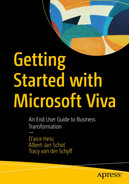I know you’re excited to start edufcating yourself about Viva Learning. But before we can get started, I need to share some concepts and principles with you on adoption, learning cultures and measurements. Although your Viva Learning will be used for more than courses related to technology, the psychology behind learning stays the same. These same principles can be applied to the introduction of Microsoft Viva in your company. After all, we are only human and to resist change comes naturally.
—Tracy
What Is Adoption?
In recent years, adoption has become a popular topic of discussion, and although well researched and documented, still very misunderstood and often not approached right. Perhaps it is all about perspectives and that IT and Business often interpret it different due to unique needs and requirements.
Now of course, what we are referring to is the act of introducing a new technology/platform to a company, and then ensuring that the employees are aware of the changes and “can” use it. Traditionally companies would embark on a Change Management Journey. And regardless of the methodology or framework they use, the focus would always be on Communication and Training (in my eyes, it is all about communication, as I believe training to be a form of communication).
Out of this IT/Business disparity, another confusion was born. And that is that consumption seems to be a measurement of or the equivalent of adoption. To fully understand adoption, let us first clarify “Consumption” and “Adoption.”
Consumption. This would be the number of people using specific products (activities/usage) during a particular period.
Adoption. This is the acceptance and integration of said technology, but more importantly, being empowered to be efficient at using it.
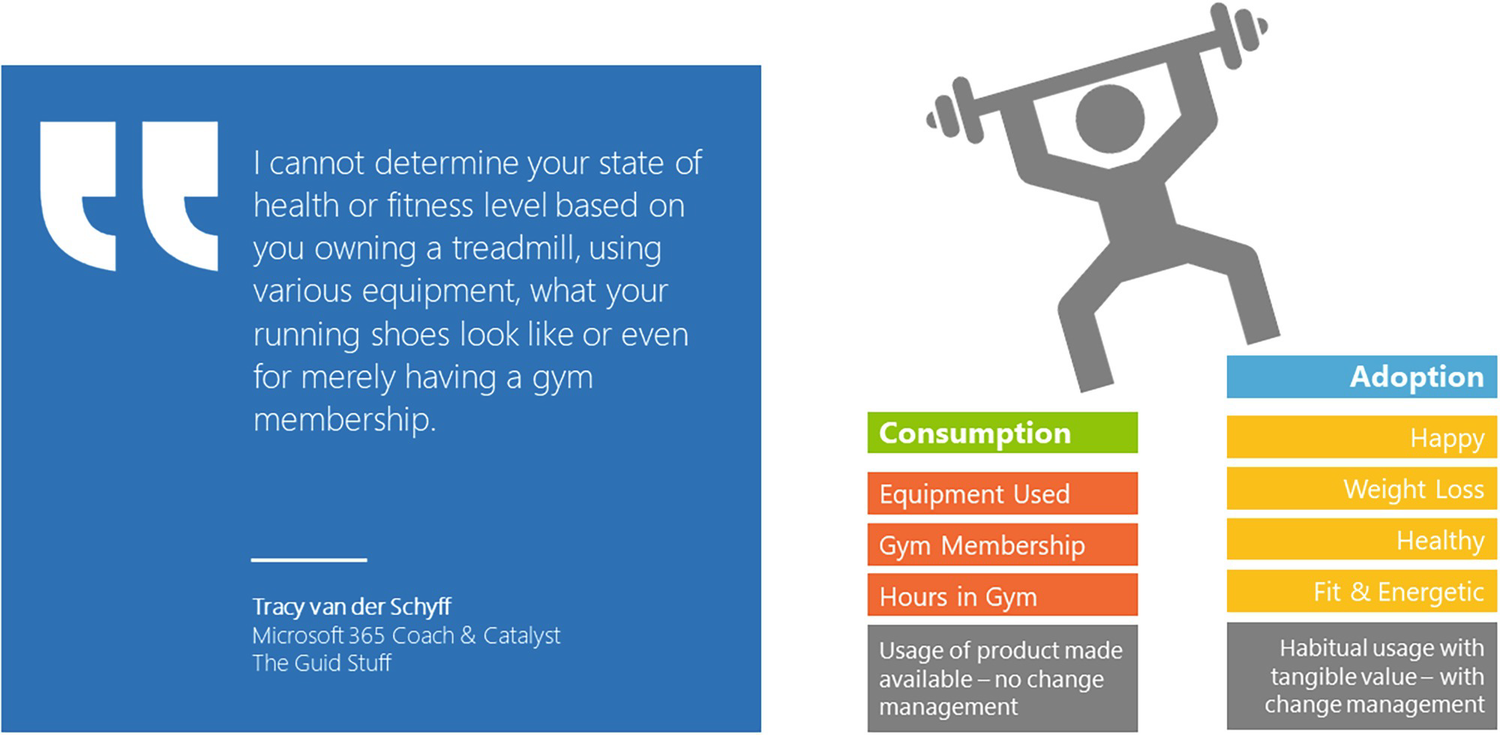
An illustration of a weightlifter, with an excerpt from Microsoft 365 coach and catalyst, and points of comparison between consumption and adoption.
Consumption vs. Adoption
Perhaps now we can agree that although consumption or usage delivers a specific measurement for adoption, it does not represent adoption in totality. To achieve true adoption, we need to invest resources to change company cultures, and importantly, the behavior and mindset of our greatest assets, our employees. If you are new to change management, the “Microsoft Service Adoption Specialist Course” is a must and will give you the necessary knowledge and tools to not only understand the task at hand, but also enable you to be instrumental in driving organizational and behavioral change in your company.
Deployment: This is the process of implementing/deploying the technical Microsoft 365 infrastructure and the assigning of licenses and apps to the employees.
Usage: This refers to employees using the technology made available to them. For example: they no longer have file shares and now use OneDrive.
Adoption: During this phase, employees start changing their habits and using the new technology becomes ingrained in their daily routine.
Proficiency: Through adoption, employees become more efficient which enables overall proficiency for their team, department, and eventually the company. This is where digital transformation is triggered.
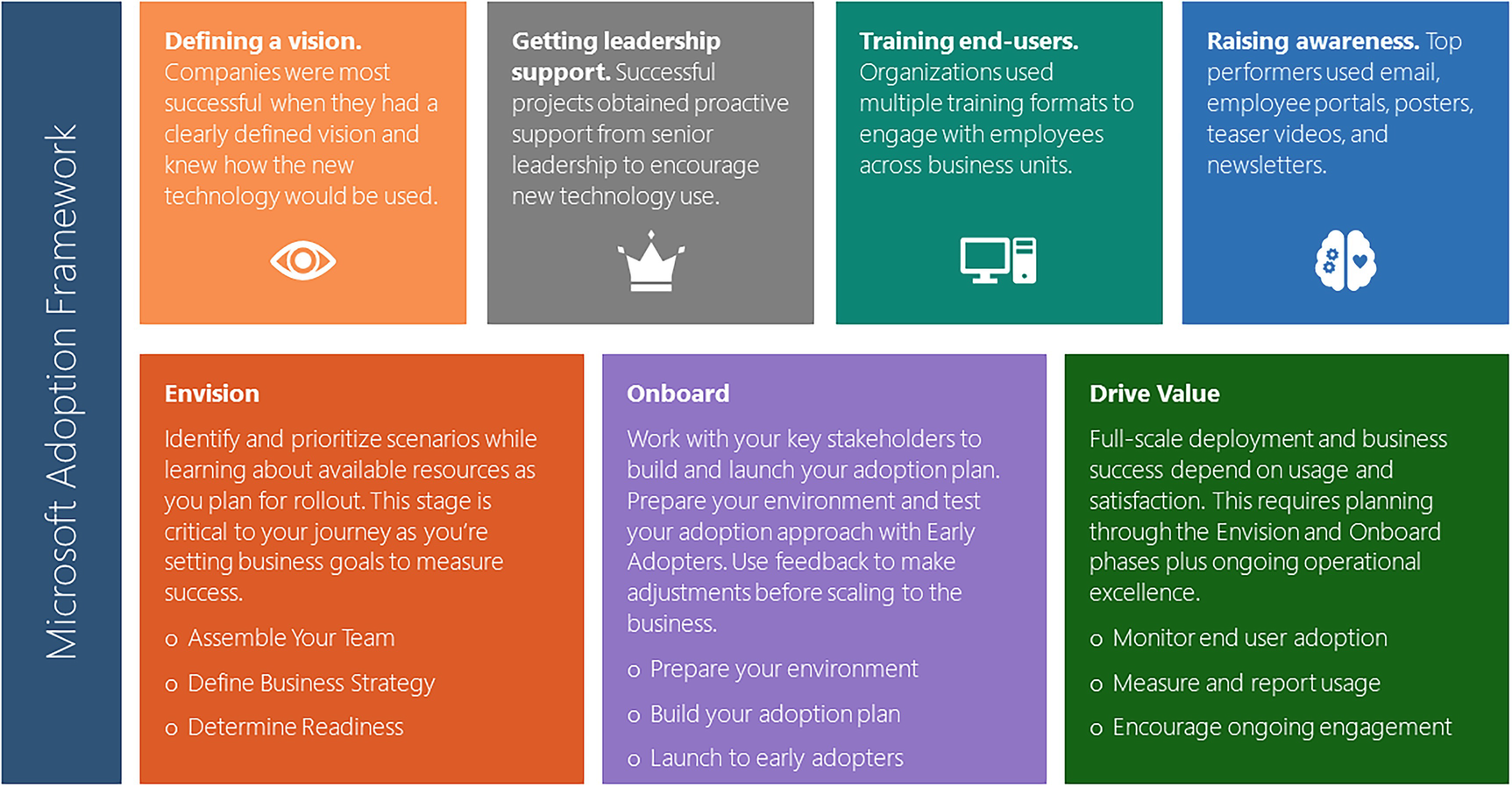
A list of agenda of Microsoft adoption framework, namely, vision, leadership support, training, awareness, envision, onboard, and drive value.
Microsoft Adoption Framework
The Impact of Training on Adoption
The IT support process
Lack of efficient training
Let us first talk about the IT support process. In the past, we locked down as much as we could and only gave our employees enough information to keep them out of trouble. When they logged calls, we would fix their issues for them, not showing them how to troubleshoot it for themselves, or even what caused it. Now of course we did some of this to protect our environments, or due to availability of resources, but it did have a serious impact on the self-esteem of our employees.
It is shocking to see how many employees still use shortcuts on their desktops and navigate to files instead of using Search, not even knowing that the Windows Button searches for files, programs, and settings. As a trainer, I know that the most difficult part of training is to remember to teach those things I have already forgotten. We tend to assume that others already know what we know, and then the necessary knowledge transfer does not take place. This led to many of our employees not having the essential foundational skills needed to navigate the modern workplace which leads into my next reason, the lack of efficient training.
We only know what we know, to ask employees to let us know when they need training would then not work. Especially not in an environment like Microsoft 365, where thousands of new features have been added to help them be more efficient and effective. Also due to the low self-esteem, many employees are too embarrassed to raise their hand and ask for help. Another contributing factor is that our employees simply do not have time to sit in training, although training does eventually save them time.
Now apart from creating a happier work environment where employees are empowered to use the available technology, are not struggling, and are not frustrated, training will also save time, and thus, save money. In research done for Microsoft by Forrester “The Total Economic Impact™ Of Microsoft Teams,” it was estimated that “4 Hours per week are saved by information workers through improved collaboration and information sharing.” Without doing any serious calculations, that is 10% of your salary bill. Read that again.
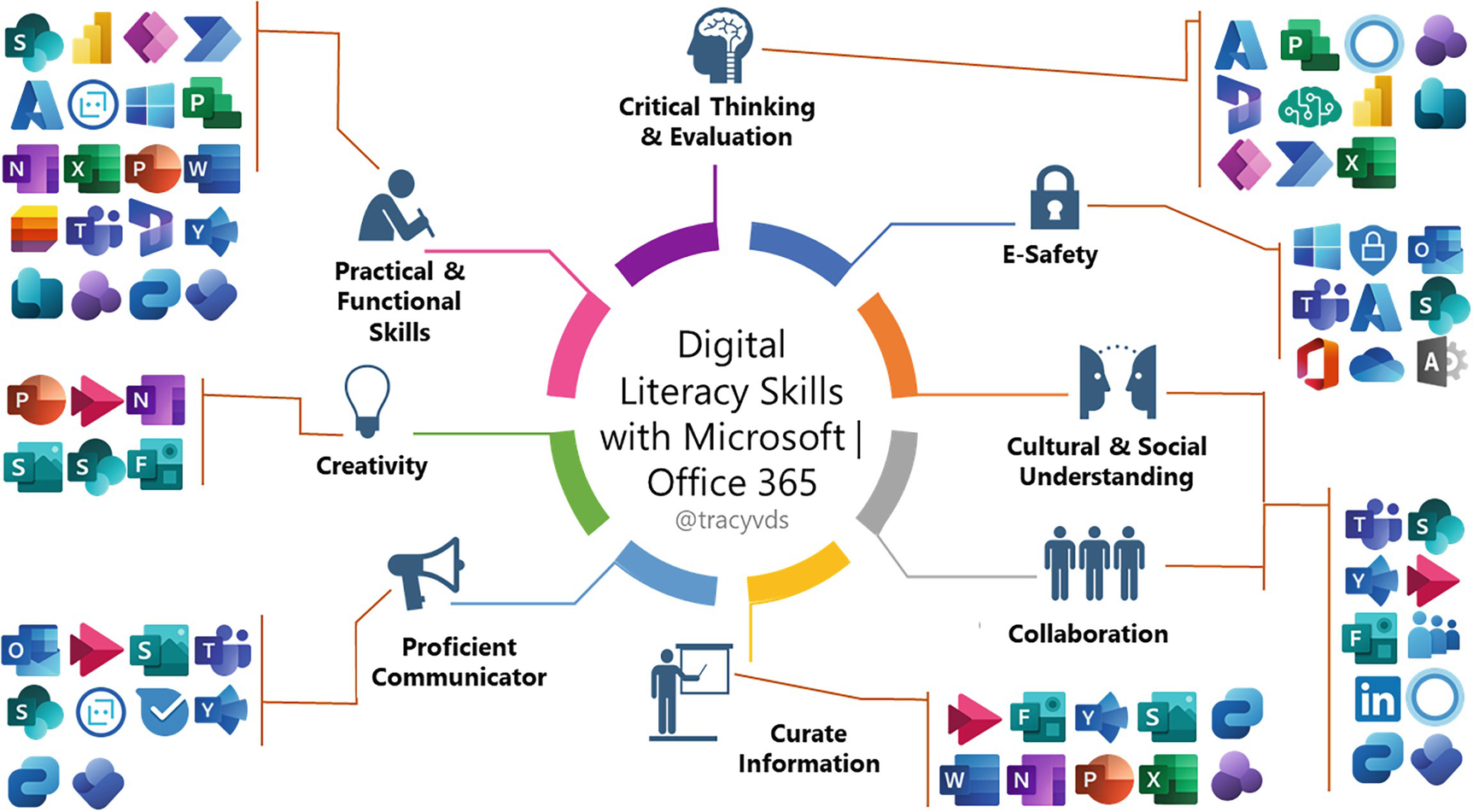
An illustration lists the icons used in digital literacy skills with Microsoft Office 365, such as creativity, collaboration, e-safety, et cetera.
Office 365 supports the development of digital literacy skills
Different Training Methods Available
Over the years, we have seen many different training methods designed, documented, and made available for training programs. Before we look at the training methods available, I will first discuss the basic learning styles.
Learning Styles
Reading/Writing
Visual
Auditory
Kinesthetic
Reading/Writing. This style entails learning by reading and writing (taking of notes). The student achieves best results by reading the training content. Examples of these would be books, articles, blogs, checklists, training guides, and manuals.
Visual. This style entails learning by seeing. The student achieves best results from having the training content visually presented. Examples of these would be images, illustrations, videos, webinars, interviews, memes and animated GIFs, PowerPoint presentations, digital flip books, screen captures, charts, graphs, and incorporating symbols and colors.
Auditory. This style entails learning by hearing. The student achieves best results from hearing spoken word. Examples of these would be group discussions, audio recordings, oral presentations, videos, and podcasts.
Kinesthetic or hands-on. This style entails learning by interacting. The student achieves best results when engaging with the learning environment. Examples of these would be quizzes, VR and AR simulations, games, interactive demos, and instructor-led and hands-on training.
Humans, being the rebels they are, do not align to only one of these training styles and benefit from mixing styles, especially when considering the content/tasks they need to learn. This is where the different types of training methods are beneficial to incorporate different styles for best results.
Learning Methods
- Instructor-led training
This refers to training facilitated by an instructor. Traditionally, this would have been in person, but now also allows for online engagements. Examples could be: Webinars, Workshops, Lectures, One-on-one, and Classrooms with smaller groups of learners.
- eLearning
eLearning of course refers to the use of technology to deliver the training. Also known as online or electronic training delivery.
- Simulation training
Simulation training requires the creation of a learning environment that mirrors real-life working scenarios.
- Hands-on training
By far the most effective learning method allows for the employee to learn while performing the task under the supervision of the trainer/facilitator.
- Coaching or mentoring
These methods tend to focus less on technical skills and more on business and personal soft skills. The focus would be on listening, feedback loops, and celebrating successes.
- Lectures and group discussions
Allowing for more discussions, these learning methods invite feedback and debates to broaden the student’s understanding of the topic.
- Role-playing
Also known as experimental learning, this method requires participants to act out different roles and interact in a scripted manner.
- Case studies
Case studies are all about “problem solving.” Similar to group discussions, a case study will be given as pre-work to then discuss and find solutions.
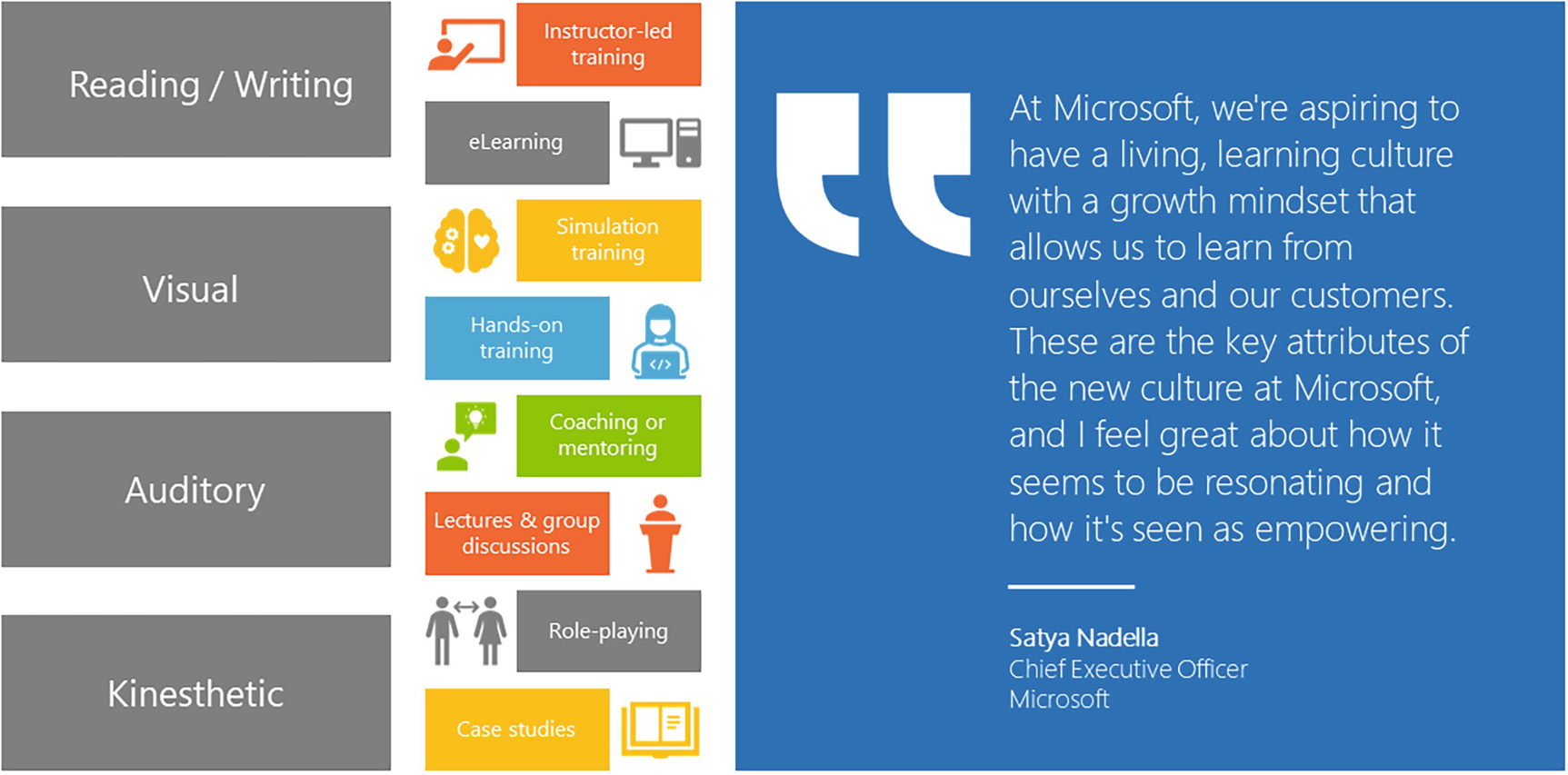
An illustration of 4 different learning styles and variegated learning methods, with an excerpt from Microsoft’s chief executive officer Satya Nadella.
Training style and methods
Keep in mind that employees who have grown accustomed to printed training manuals over the years, would struggle to adopt to video training only, without the necessary change management.
Over the next few chapters, you will gain a better understanding of the impact of training and how to incorporate these different styles/methods into your employees’ daily working lives.
Changing Learning Cultures
The saying “you can lead a horse to water, but you can't make him drink” applies so much to training, it could have been written specifically for it. In my nearly 20 years working with SharePoint and later Microsoft | Office 365, this was proven to me time and time again. What am I referring to, you might ask? Well, it insinuates that most people will not learn on their own, even when content is made available. I am NOT saying that people do not want to empower themselves, the sad truth is that most companies’ culture and strategic objectives are not supportive of this.
Microsoft's corporate mission is “to empower every person and every organization on the planet to achieve more.” This statement is not only focused externally, but also embraced internally by encouraging employees to allocate time to learning and evolving. Time being the magic word here and as we are finding ourselves in a time where autonomy fosters innovation, the knowledge to do so is crucial. Microsoft’s commitment toward changing their company culture for the better is obvious from their “refreshed” leadership principles (Figure 4-5).

An image lists three leadership principles practiced in Microsoft, with a concomitant excerpt from its chief executive officer Satya Nadella.
Microsoft’s leadership principles
Measurement and Analytics
Measurement is an important part of the adoption process where we should track both usage and behavior. Without having detail of previous and future states, you will never be able to say whether the transition was successful or not. Especially when deploying learning platforms, the ability to track behavioral change plays an instrumental role in your company’s digital transformation.
Microsoft supplies us with various reports and analytics to help us analyze the progress, and then implement corrective actions for greater/different results.
Microsoft 365 Usage Report
Microsoft 365 Usage Analytics (Power BI)
Microsoft Teams Analytics and Reporting
Microsoft Productivity Score
User Satisfaction Surveys
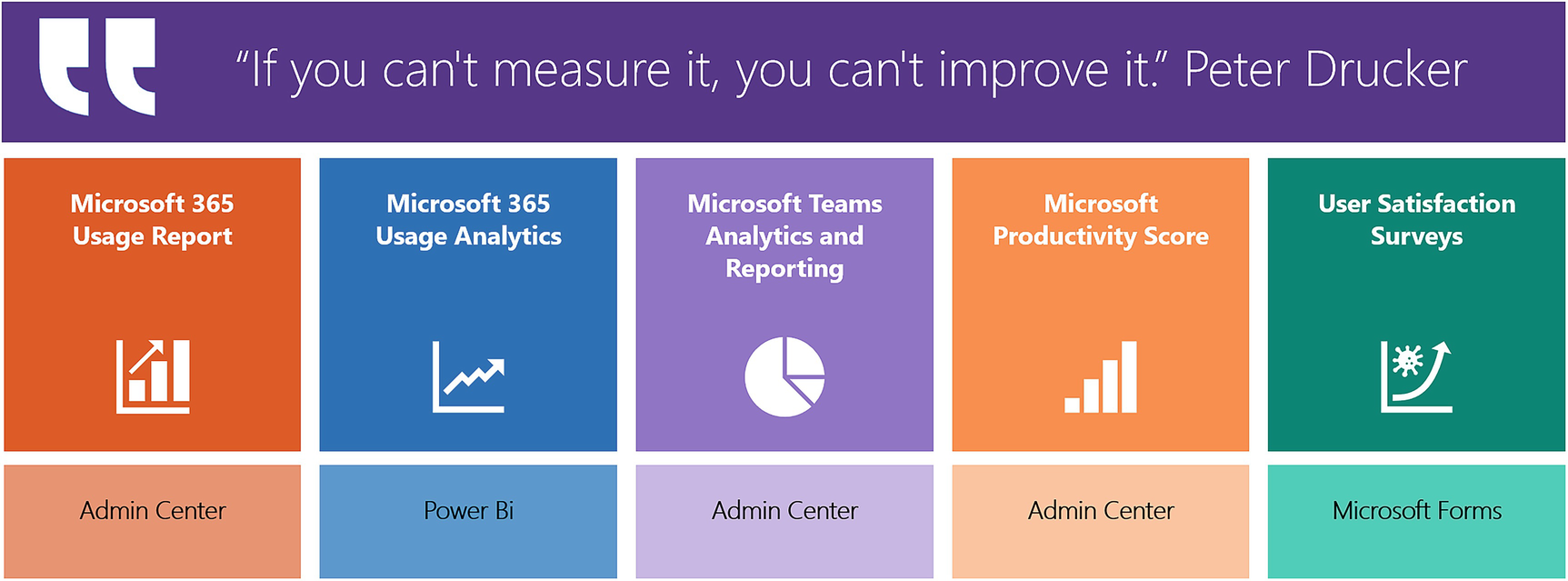
A list of the icons for Microsoft’s usage report and analytics, productivity score, and user satisfaction surveys, with an excerpt from Peter Drucker.
Microsoft measurement and analytics
Microsoft 365 Usage Report
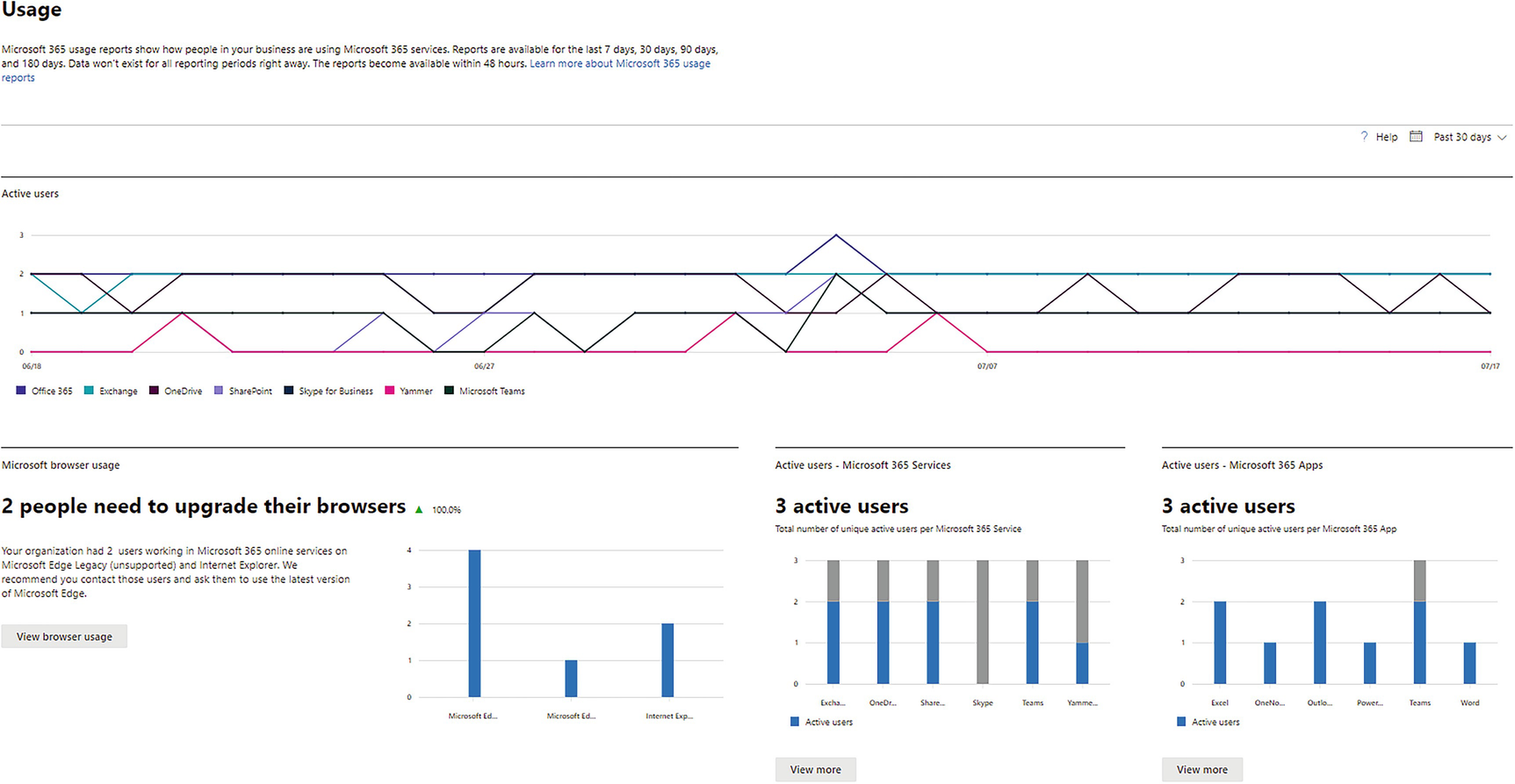
A line graph and three bar graphs track the change in the number of active users of various Microsoft applications over specific time periods.
Microsoft 365 usage report first section
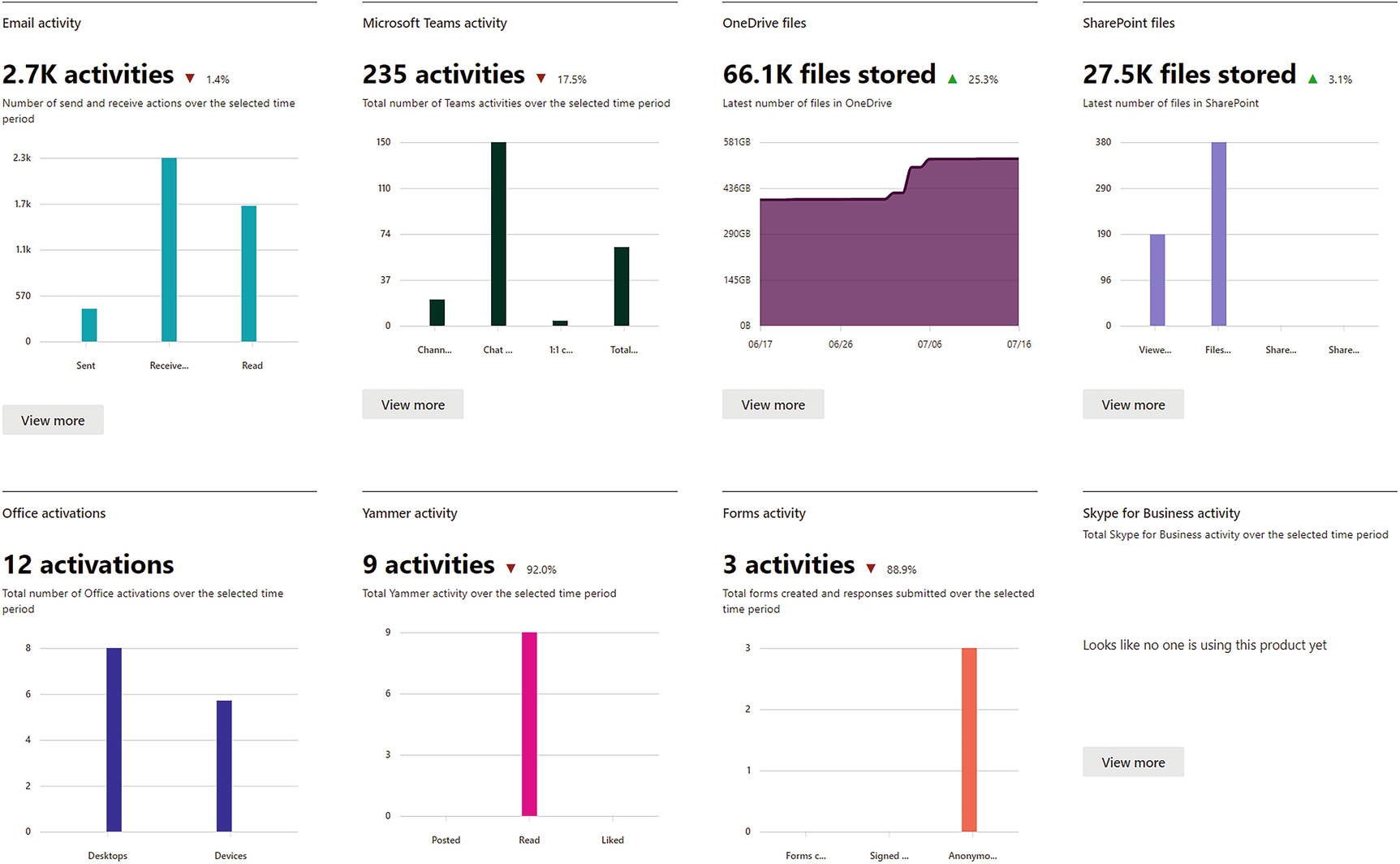
A line graph and three bar graphs track the change in the number of activities in various Microsoft applications over specific time periods.
Microsoft 365 usage report second section
Microsoft 365 Usage Analytics
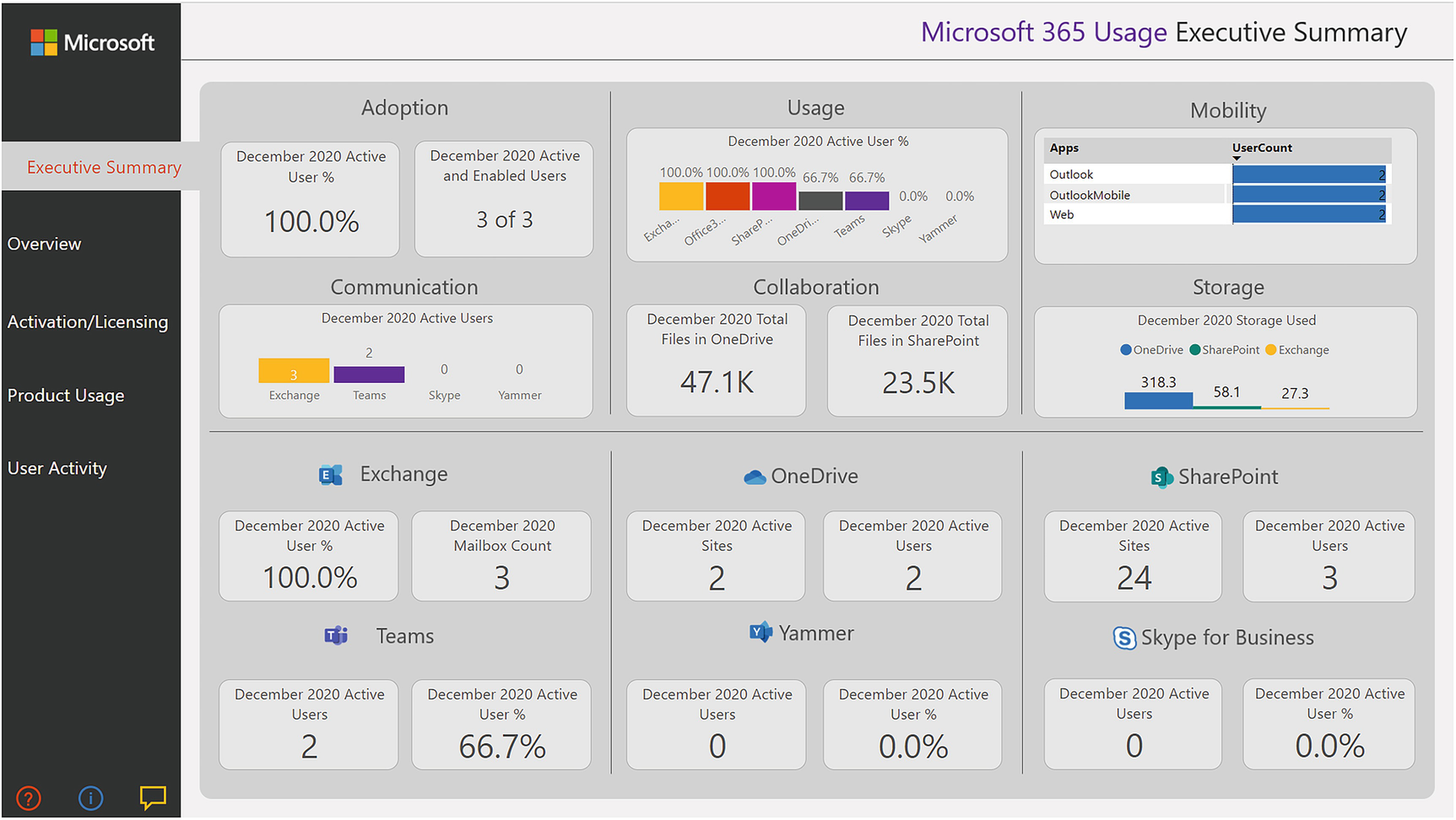
A screenshot of the Microsoft 365 usage executive summary depicts adoption, usage, mobility, communication, collaboration, and storage data for various apps.
Microsoft 365 usage – executive summary
Microsoft Teams Analytics and Reporting

A screenshot of usage reports of Microsoft Teams lists the measurement criteria for apps, activity, P S T N, device, live event, and direct routing.
Microsoft Teams Analytics – available reports
Microsoft Productivity Score
The Microsoft Productivity Score can be found in the Microsoft 365 admin center under reports. Of all the reports available, I find this report most valuable as it tracks behavior and not just consumption (usage).
For more information on the Productivity Score and how it gets calculated, see the Microsoft Productivity Score documentation.
Metrics supplies the actual data which can be used to determine your company’s progress in their digital transformation journey.
Insights about the data deliver the analytics on the preceding metrics to help with making decisions and identifying opportunities for improvement.
Recommended actions are guidelines and resources from Microsoft to facilitate the change in behaviors.
People experiences looks at categories like content collaboration, mobility, communication, meetings, and teamwork.
Technology experiences focus on performance and health issues with your hardware and software.

A screenshot of the Microsoft 365 productivity score depicts line graphs for communication, meetings, content collaboration, teamwork, mobility, and total score.
Microsoft Productivity Score – main dashboard
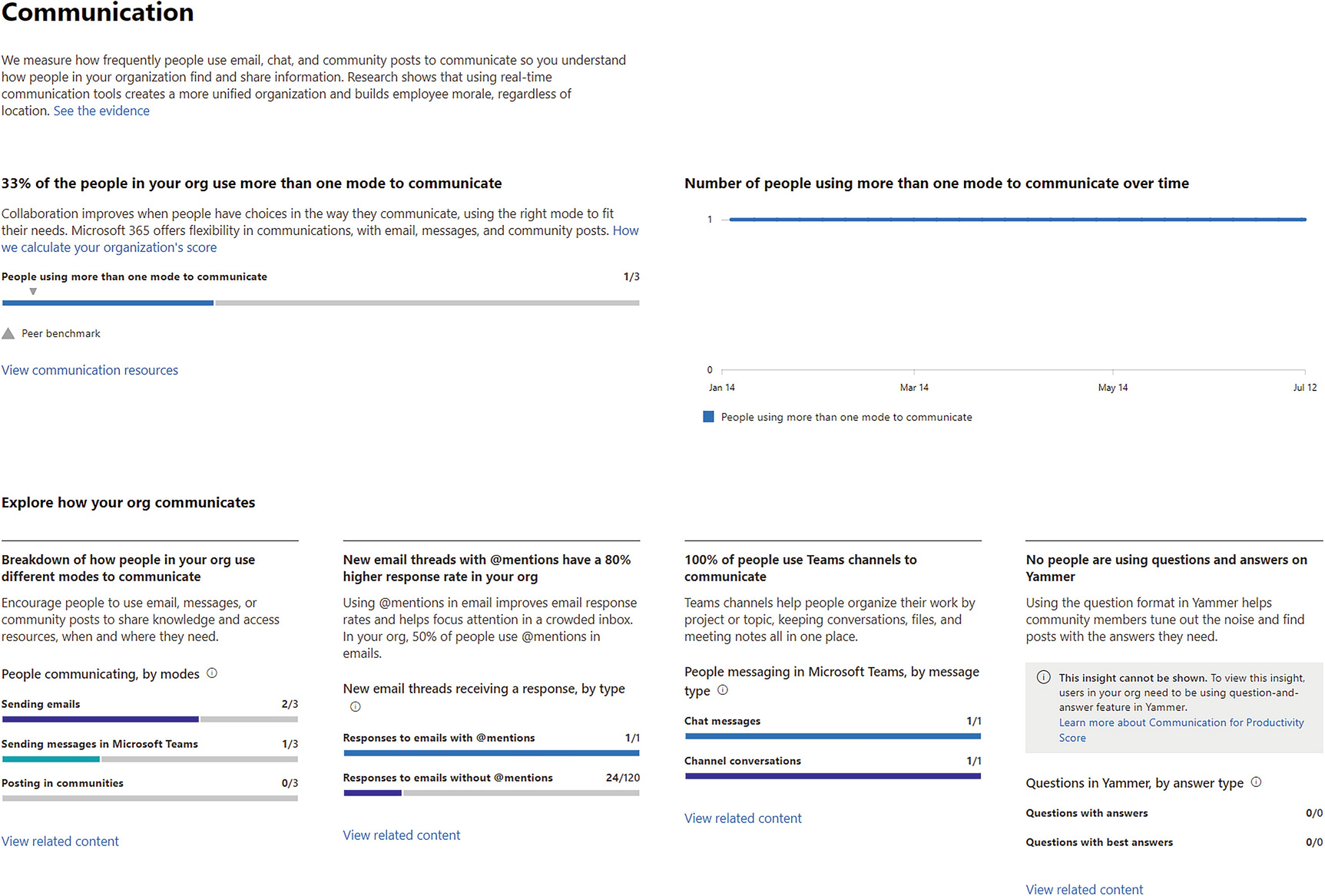
A screenshot depicts the data for various modes of communication in your organization, such as email, chat, and community posts, using Microsoft’s tools.
Microsoft Productivity Score – communication
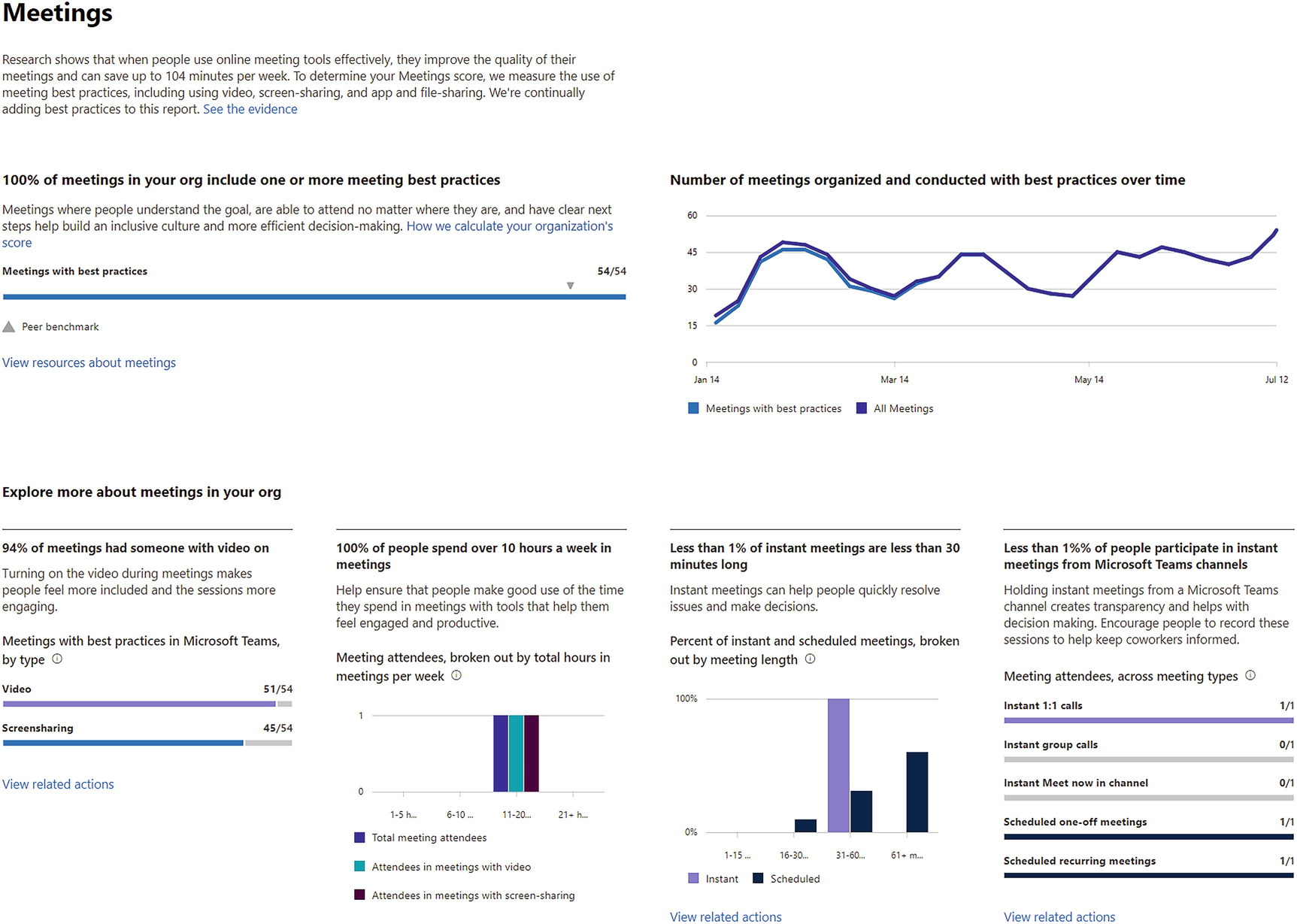
A screenshot depicts the tracking data for time duration and best practices employed in the meetings of your organization, using Microsoft’s tools.
Microsoft Productivity Score – meetings
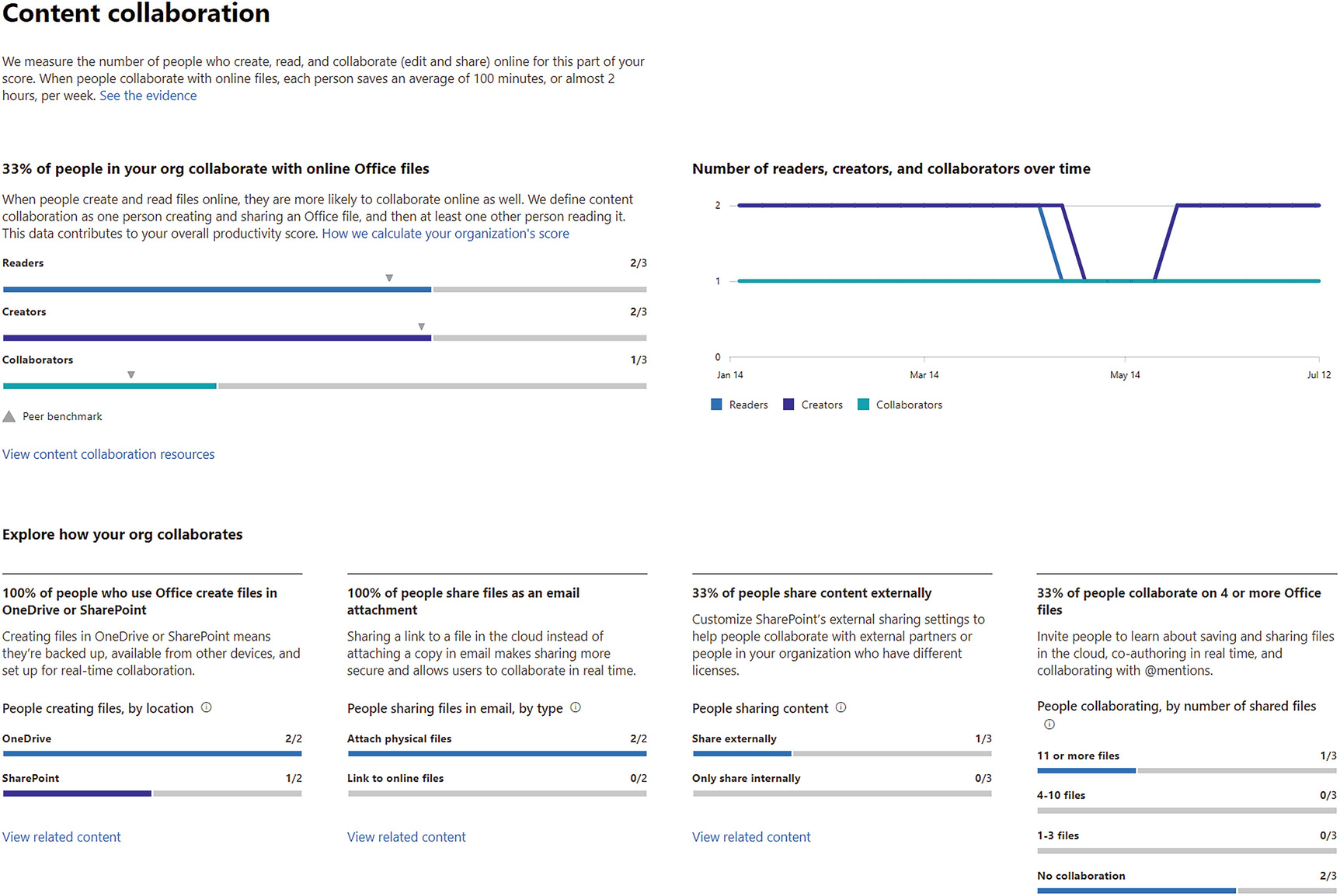
A screenshot depicts the content collaboration data of how readers, creators, and collaborators use different Microsoft’s tools.
Microsoft Productivity Score – content collaboration
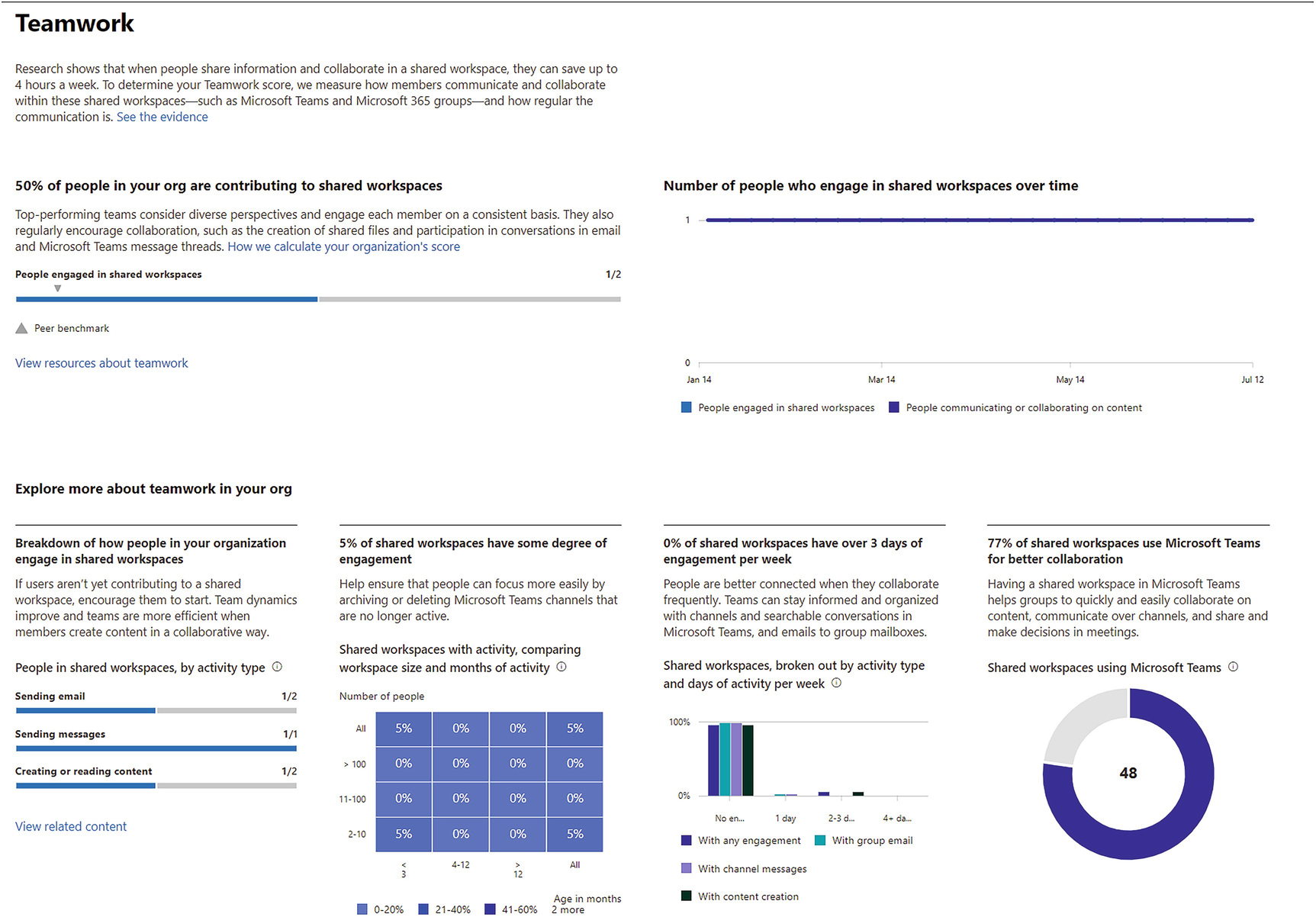
A screenshot depicts teamwork data of the modes of engagement, communication, and collaboration of members in a shared workspace using Microsoft’s tools.
Microsoft Productivity Score – teamwork
